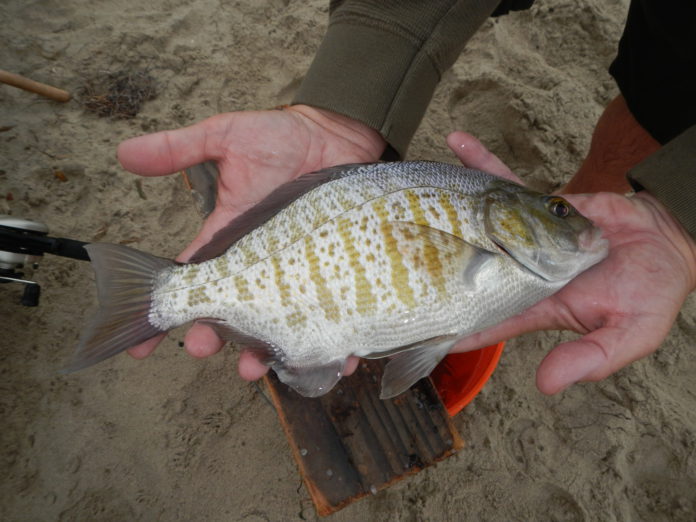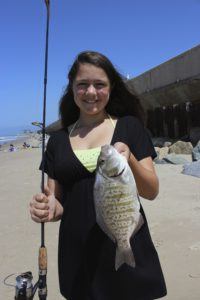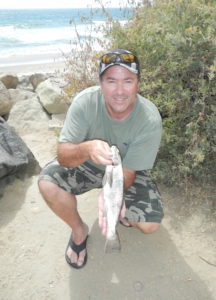
BY TIM E. HOVEY
As the hunting season comes to a close and we slide into spring, one of my favorite outdoor activities is to grab a light tackle fishing rod and head down to the beach to fish for barred surfperch. At the shores of the Southern California beaches is where I cut my fishing teeth as a kid. Wading the surf, and feeling the sand under my feet takes me back to when all that mattered was catching the most and the biggest perch. Watching the surf and picking a fishing spot makes me feel like a kid again, and that will never change for me. I will always make time to cast the coast when the weather warms up.
One of the reasons I have stayed so involved with fishing the surf each year is the pure convenience of the activity. I’ve often been on my way someplace and just stopped off at the coast to cast to the small waves to see what was biting. During the spring and into the summer, a small tackle pack, a five-gallon bucket and a light rod are always in my truck just in case I get the urge.

Despite my pull to the coast, there are surf conditions that clearly suggest I should find something else to do that day. Large waves are certainly fishable, but often stir up aquatic debris, like sea weed, which makes fishing light tackle frustrating. If I plan a trip to the beach, I’ll always reference the local surf report to get the latest information on ocean conditions. Not only can you see current and projected surf conditions, more importantly you can see what the surf has been doing over the previous 12 hours. High overnight surf usually means heavy ocean debris and I will more than likely pass on a perch safari.
For me, ideal surf conditions are simple: small waves in the 1- to 2-foot range and an early low tide coming to high. Calmer overnight surf conditions will keep the water clean and incoming tidal waters usually triggers an insane perch bite if you locate the proper spot.
How the waves break on shore will show you where fish hang out and feed. I like to fish areas of chaos. Surf that hits the shore at different angles will stir up more sand. This in turn kicks up shoreline invertebrates like bloodworms and sand crabs, drawing fish to the area. Locating a sand crab bed in these chaotic surf zones is also a plus. Start fishing in these sections of the beach and bites will come.
There’s no need to load yourself down with terminal tackle. A simple Carolina rig tipped with either a fresh sand crab or a Berkley Gulp! Sandworm will get the job done. Fishing 10-pound main line and dropping that to 6- or 8-pound test at the leader completes the rig. My small tackle pack rarely contains more than spare rig components, extra line and a couple packages of lures.
Fishing the morning tide when the water is colder keeps the beaches crowd free and you can literally have much of the beach all to yourself. Reduced crowds and wide open spaces makes fishing the shore ideal for anglers just getting started. The frequent bites makes for an exciting first time trip for the beginner and the flat sand beach allows new anglers to refine their casting abilities free from tangles and snags. At the beach is where I taught both my daughters how to fish, too.
While surf fishing for perch is relatively easy to do, two mistakes I see new anglers make is that they cast too far out and they don’t stay in constant contact with their bait. Surfperch by definition feed aggressively in the surf. Casting over the waves into calmer water may get you bites, but the real action is occurring in 1 or 2 feet of water, where the surf is churned up and chaotic.
A more important tip is to make sure that you can feel everything that bait is doing at the end of your line. You’ll miss bites or pick-ups if you don’t keep your line tight and free of slack. Surfperch run the sensitivity spectrum when it comes to picking up your bait. Some bites are nothing more than subtle ticks on the line, while others can just about rip the rod from your hands. Be ready for both and know what your bait is doing while it’s in the water.
Another thrill for me is that a multitude of fish species cruise these coastal shallows

in search of food. In the areas I usually fish, the predominant species is the barred surf perch, but you certainly could hook into other species. I’ve pulled legal halibut, yellowfin croaker, corbina and leopard sharks from the surf on light tackle. I’ve also hooked things that have picked up my offering and headed out to deeper water without stopping. The potential species variety and the possibility of tangling with something far larger than expected is always that undeniable allure of fishing the coast.
Walking the soft sand beaches and casting the coast is something I’ve done all my life. It’s an easy and convenient type of angling that connects me to a simpler time. Most that know me understand that as the days get longer and the weather starts to warm, on the beach is likely where you’ll find me.



